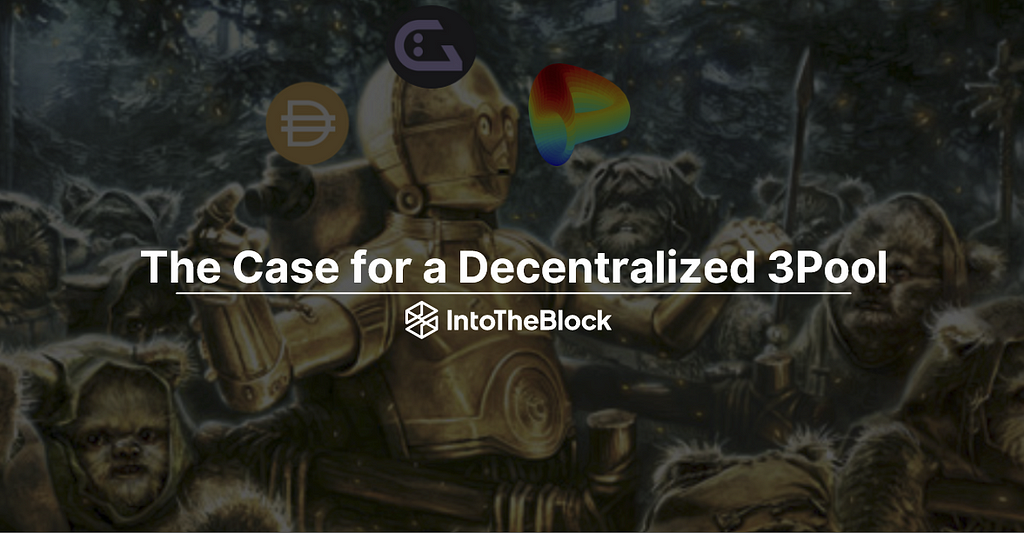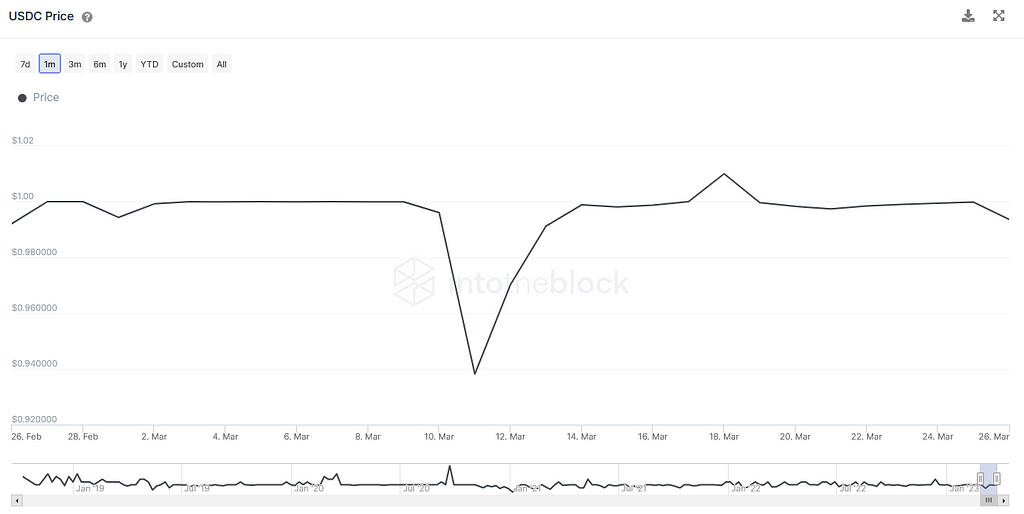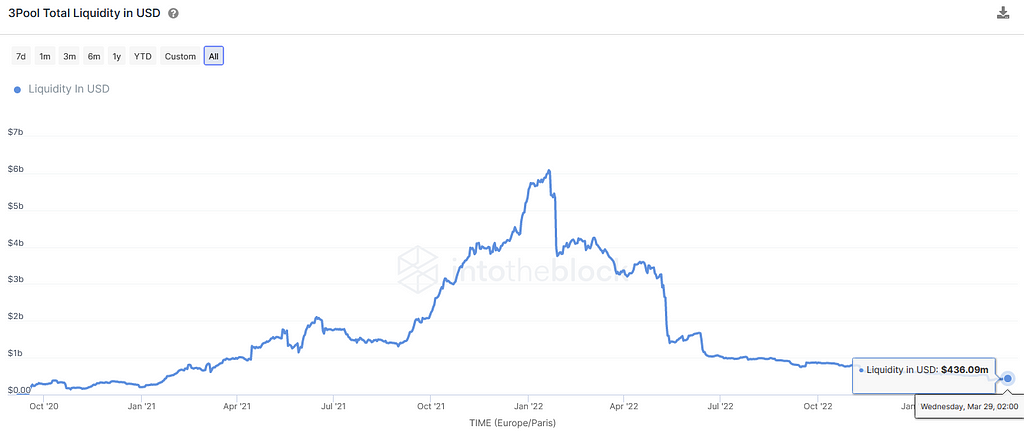Latest news about Bitcoin and all cryptocurrencies. Your daily crypto news habit.
With recent volatility amongst stablecoins and the upcoming launch of Aave’s GHO and Curve’s crvUSD, the time is right to make a change to one of DeFi’s most well-known stablecoin pools

The rise of CDP 3Pool-0
The last year has been a volatile period for stablecoins. Two major existential events have forced crypto users to rethink the normally non-volatile stablecoin markets. The first large shock was the total collapse of UST. The collapse of the algorithmic stablecoin brought into question the feasibility of the entire algorithmic design. The second shock is the recent depegging event of USDC. What had been seen as one of the most resistant stablecoins in the ecosystem, was momentarily at the mercy of the traditional finance world, when two banks that it operated with collapsed. This left users unable to redeem their USDC for USD during the weekend of March 10–12 and subsequently induced a run in the markets as people traded their USDC for other stablecoins. The chart below highlights the peak panic price of about $0.94 on Saturday, while it was still unclear if USDC was fully backed and users were not able to redeem.

Source: IntoTheBlock UDSC Analytics
These two events highlight two points on the outlook of stablecoins in the crypto ecosystem, collateral backed stablecoins are currently the best way to hold value in non-volatile assets and there needs to be more stablecoin options that are decentralized.
The upcoming Aave GHO and Curve crvUSD stablecoins both satisfy the two points above. In addition, they are being launched by two of the most successful and longest enduring protocols in crypto. Both being slightly different versions of a collateralized debt position (CDP) stablecoin issued by two of the four largest protocols by TVL, positions these stablecoins to have initial rapid growth and adoption.

Source: Defillama
To continue the effort in the crypto ecosystem to mitigate centralization risks while providing stable assets that can hold value, the idea of a new CDP 3Pool (GHO,crvUSD,DAI) should be considered as an option that can help achieve those efforts.
To better understand the implications of a new CDP 3Pool, we will dive into some of the underlying aspects of the upcoming GHO and crvUSD stablecoins. Then we will compare differences between the original and newly proposed 3Pools.
Make the Crypto World GHO ‘Round
While a deep-dive into GHO mechanics can be found from IntoTheBlock here, this article will focus on three components of GHO that are relevant for its resiliency in a pool:
Pegging mechanisms
GHO will primarily rely on market forces to maintain its peg. Since GHO will be redeemable at $1, if it is trading above or below the peg on the open market, users are incentivized to bring it back to peg. Above $1, users can mint GHO and then sell it on the open market, pocketing the premium and paying back the loan when it has re-pegged. Below $1, users that have open mint positions are incentivized to buy GHO from the market at a discount to pay back their loan.
Bad debt prevention
The main preventative measure against bad debt for GHO will be both the choices of collateral used to mint GHO and the flashmint function that will be enabled. Currently most of the collateral on Aave v3 markets are well-known assets with high market caps. This means that manipulation of these assets will be difficult and should reduce the risk of bad debt. These collaterals paired with the flashmint function that will work similar to a flashloan and will mint GHO repay a loan and liquidate the collateral in one block. This should reduce complexity and potentially reduce the cost of GHO liquidations.
Utility
While all potential utilities are unclear with GHO not yet launched, strong use cases are important to drive demand. GHO already has many utilities that should make it a popular choice. Using the testnet for GHO as an indicator, minting GHO should be relatively cheap compared to borrowing other stablecoins which will incentivize users to pay off loans of other stables to mint GHO instead.. The testnet currently states interest rates for minting GHO between 1.62–2.02%. With low rates, new opportunities will arise, such as rate arbitrage between stablecoin markets on Aave and cheaper long/short strategies for other assets. Another utility that should arrive around the same time as GHO is Aave’s portals. This will allow users to transfer GHO between chains without a third-party bridge, eliminating many bridge risks.
crvUSD on the Horizon
Curve’s crvUSD appears that it will launch after GHO and many of the specific details on general interest rates to mint and collateral to be used are still unknown. However, from the whitepaper that was released last year, the three components like what was reviewed above for GHO are available:
Pegging mechanisms
crvUSD, similar to GHO, will mainly rely on the markets to arbitrage the prices back to peg. If a depeg occurs for a prolonged period, the crvUSD design will have an Automatic Stabilizer mechanism that will mint or burn crvUSD to bring it back to peg.
Bad debt prevention
Curve’s novel LLAMMA (Lending-Liquidating AMM Algorithm) model is designed to gradually sell off collateral as its price drops. This gradual liquidation design means that there should always be sufficient collateral to cover and pay off the loan. However, if for some reason liquidations are not happening via LLAMMA, external liquidators will be incentivized to liquidate the positions.
Utility
A clear utility for minting crvUSD is the gradual liquidation design that is implemented in the LLAMMA model. This will provide more flexibility in using the crvUSD positions as hedging strategies because you will only get gradually liquidated instead of having a 30%+ loss of collateral immediately. Though it is not confirmed yet, another potential utility is being able to unlock capital in LP positions by using them to mint crvUSD. This feature would have a large impact on liquidity in the market.
Traditional 3Pool vs. New CDP 3Pool
The original
The original 3Pool consisting of USDT,USDC, and DAI is one of the largest and most well known pools on Curve. At its peak, it held over $6B in assets and with the use of Curve’s Stableswap AMM, it is able to make large swaps between the three stablecoins with minimal slippage and price impact to the user. However, TVL has been in a slow decline. The bear market has definitely had its impact on total liquidity in the pool, but low incentives compared to pools found in other protocols has also taken its toll. This is where a CDP 3Pool could have an advantage.

Source: IntoTheBlock Curve Analytics
CDP 3Pool
After the UST and USDC events of this year, it is safe to assume that there is a growing appetite for collateral backed decentralized stablecoins. Just on this alone, a CDP 3Pool makes sense and will most likely get immediate traction. However, another advantage of this pool is the possibility for a coordinated rewards scheme from each of the stablecoin’s protocols. Since each protocol has a governance system, token, and treasury set up, a coordinated voting effort to incentivize the pool could produce attractive yields for the pool creating a flywheel effect encouraging more minting. Aave governance has already started a conversation about GHO liquidity incentives, indicating that there will be a push by Aave to build GHO traction and deepen liquidity pools. Furthermore, if the 3Pool were to be on Curve, veCRV voters would have an incentive to vote for rewards to be directed to this pool as they will receive rewards from the fees generated by crvUSD.
Final Thoughts
A criticism to the creation of this 3Pool is that it could further fragment liquidity by splitting pool TVL between the original 3Pool and the new CDP 3Pool. While this could be the case, these two stablecoins will be launched regardless. This could be an opportunity to change liquidity in the ecosystem in a way that brings more decentralization with comparable security.
The CDP 3Pool would have a lot of potential. Synchronized efforts in incentives and governance between Aave, Curve, and Maker could push this new pool to become one of the largest stablecoin pools in the space. It is not easy to determine how much TVL the pool could attract in the beginning, but as an indicator, there is 3.3M stkAAVE in the Aave safety module. This means that $330M GHO could be minted at a 1.62% interest rate. Even if a third of this went to the CDP 3Pool and was matched with equal amounts of crvUSD and DAI, the pool would already be nearly 75% the size of the current TVL in the original 3Pool.
The Case for a Decentralized 3Pool was originally published in IntoTheBlock on Medium, where people are continuing the conversation by highlighting and responding to this story.
Disclaimer
The views and opinions expressed in this article are solely those of the authors and do not reflect the views of Bitcoin Insider. Every investment and trading move involves risk - this is especially true for cryptocurrencies given their volatility. We strongly advise our readers to conduct their own research when making a decision.